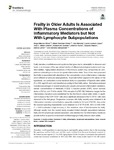Mostrar o rexistro simple do ítem
Frailty in older adults Is associated with plasma concentrations of inflammatory mediators but not with lymphocyte subpopulations
| dc.contributor.author | Marcos-Pérez, Diego | |
| dc.contributor.author | Sánchez-Flores, María | |
| dc.contributor.author | Maseda, Ana | |
| dc.contributor.author | Lorenzo-López, Laura | |
| dc.contributor.author | Millán-Calenti, José Carlos | |
| dc.contributor.author | Gostner, Johanna | |
| dc.contributor.author | Fuchs, Dietmar | |
| dc.contributor.author | Pásaro, Eduardo | |
| dc.contributor.author | Laffon, Blanca | |
| dc.contributor.author | Valdiglesias, Vanessa | |
| dc.date.accessioned | 2019-01-22T11:26:27Z | |
| dc.date.available | 2019-01-22T11:26:27Z | |
| dc.date.issued | 2018-05-16 | |
| dc.identifier.citation | Marcos-Pérez D, Sánchez-Flores M, Maseda A, Lorenzo-López L, Millán-Calenti JC, Gostner JM, Fuchs D, Pásaro E, Laffon B, Valdiglesias V. Frailty in older adults Is associated with plasma concentrations of inflammatory mediators but not with lymphocyte subpopulations. Front Immunol. 2018 May 16;9:1056. | es_ES |
| dc.identifier.issn | 1664-3224 | |
| dc.identifier.uri | http://hdl.handle.net/2183/21614 | |
| dc.description.abstract | [Abstract] Frailty denotes a multidimensional syndrome that gives rise to vulnerability to stressors and leads to an increase of the age-related decline of different physiological systems and cognitive abilities. Aging-related alterations of the immune system may compromise its competence culminating in a chronic low-grade inflammation state. Thus, it has been proposed that frailty is associated with alterations in the concentration of pro-inflammatory molecules and in different lymphocyte subpopulations. To provide further support to the validity of that hypothesis, we conducted a cross-sectional study in a population of Spanish older adults (N = 259, aged 65 and over) classified according to their frailty status. Biomarkers analyzed included percentages of several lymphocyte subsets and several inflammation mediators, namely concentrations of interleukin 6 (IL6), C-reactive protein (CRP), tumor necrosis factor α (TNFα), and 75 kDa soluble TNFα receptor II (sTNF-RII). Reference ranges for the inflammation mediators were established for the first time in robust older adults. A significant increase in the CD4+/CD8+ ratio and a significant decrease in the % CD19+ cells were observed in the frail group. Progressive increases with frailty severity were obtained in all inflammatory mediator concentrations, especially notable for IL6 and sTNF-RII. Area under the receiver-operating characteristic curve obtained for sTNF-RII (0.90, 95% CI 0.85–0.94, P < 0.001) indicates a high accuracy in the predictive value of this biomarker for frailty. Although results from the current study revealed limited strength associations between frailty and the lymphocyte subsets assessed, data obtained for the inflammatory mediators provide further support to involvement of inflammaging in frailty status in older adults. | es_ES |
| dc.description.sponsorship | Xunta de Galicia; ED431B 2016/013 | es_ES |
| dc.description.sponsorship | Xunta de Galicia; ED431C 2017/49 | es_ES |
| dc.description.sponsorship | Xunta de Galicia; IN607C 2016/08 | es_ES |
| dc.description.sponsorship | info:eu-repo/grantAgreement/MINECO/Programa Estatal de Promoción del Talento y su Empleabilidad/RYC-2015-18394/ES/ | |
| dc.language.iso | eng | es_ES |
| dc.publisher | Frontiers | es_ES |
| dc.relation.uri | https://doi.org/10.3389/fimmu.2018.01056 | es_ES |
| dc.rights | Creative Commons Attribution 4.0 International License (CC-BY 4.0) | es_ES |
| dc.rights.uri | http://creativecommons.org/licenses/by/4.0/ | * |
| dc.subject | C-reactive protein | es_ES |
| dc.subject | Interleukin 6 | es_ES |
| dc.subject | Frailty | es_ES |
| dc.subject | Inflammaging | es_ES |
| dc.subject | Lymphocyte subpopulations | es_ES |
| dc.subject | Tumor necrosis factor alpha | es_ES |
| dc.subject | Soluble TNF alpha receptor II | es_ES |
| dc.title | Frailty in older adults Is associated with plasma concentrations of inflammatory mediators but not with lymphocyte subpopulations | es_ES |
| dc.type | info:eu-repo/semantics/article | es_ES |
| dc.rights.access | info:eu-repo/semantics/openAccess | es_ES |
| UDC.journalTitle | Frontiers in Immunology | es_ES |
| UDC.volume | 9 | es_ES |
Ficheiros no ítem
Este ítem aparece na(s) seguinte(s) colección(s)
-
INIBIC-IX - Artigos [31]






